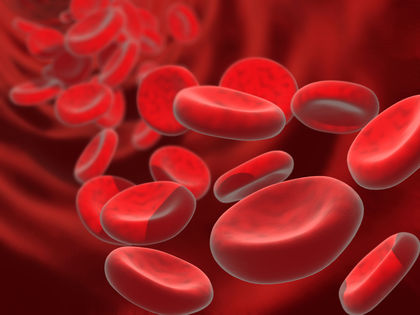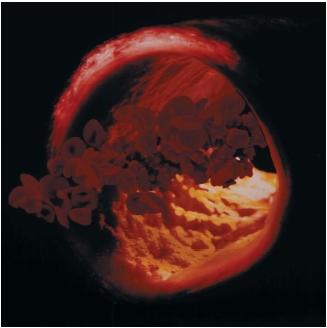Blood

Blood is a fluid connective tissue that performs many functions in the body. It carries oxygen and nutrients to the cells, hormones (chemical messengers) to the tissues, and waste products to organs that remove them from the body. Blood also acts as a defense against foreign microorganisms and helps to keep the body at a constant temperature in warm-blooded animals.
Blood consists of white blood cells, red blood cells, and platelets suspended in plasma, a watery, straw-colored fluid. Plasma makes up about 55 percent of the blood, while blood cells and platelets make up the remaining 45 percent. The average adult human body contains about 6 quarts (approximately 5.6 microliters) of blood.
Plasma
Plasma is made up of 92 percent water, 7 percent proteins, salts, and other substances it transports. Fibrinogen is an important protein involved in blood clotting. Albumins and globulins are proteins that aid in the regulation of fluid in and out of the blood vessels. Proteins called gamma globulins act as antibodies and help protect the body against foreign substances, called antigens.
The salts present in plasma include sodium, potassium, calcium, magnesium, chloride, and bicarbonate. They are involved in many important body functions such as muscle contraction, the transmission of nerve impulses, and regulation of the body's acid-base balance. The remaining substances in plasma include nutrients, hormones, dissolved gases, and waste products that are being transported to and from body cells. These materials enter and leave the plasma as blood circulates through the body.
Words to Know
Capillary: Microscopic vessels in the tissues that are involved in the exchange of nutrients and other substances between the blood and the tissues.
Clotting factor: A substance that promotes the clotting of blood (stoppage of blood flow).
Erythrocyte: A red blood cell.
Fibrin: A protein in plasma that functions in blood clotting by forming a network of threads that stop the flow of blood.
Hemoglobin: The protein pigment in red blood cells that transports oxygen to the tissues and carbon dioxide from them.
Hemophilia: A genetic disorder in which one or more clotting factors is absent from the blood, resulting in excessive bleeding.
Leukocyte: A white blood cell.
Plasma: The straw-colored liquid portion of the blood that contains water, proteins, salts, nutrients, hormones, and wastes.
Platelet: A disk-shaped cell fragment involved in blood clotting.
Proteins: Large molecules that are essential to the structure and functioning of all living cells.
Red bone marrow: The soft reddish tissue in the cavity of bones from which blood cells are produced.
Red blood cells
The main function of red blood cells, or erythrocytes (pronounced uh-REE-throw-sites), is the transport of oxygen from the lungs to body tissues. Erythrocytes are tiny disk-shaped structures that are hollowed out on either side. Their small size allows them to squeeze through microscopic blood vessels called capillaries. They number about 5 million per cubic millimeter of blood; in the entire human body, there are about 25 trillion red blood cells.
Red blood cells are formed in the red bone marrow of certain bones, where they produce a substance called hemoglobin. Hemoglobin is a protein pigment that contains iron and that gives red blood cells their color. The hemoglobin in red blood cells combines with oxygen in the lungs, transporting that oxygen to the tissues throughout the body. It also carries carbon dioxide from the tissues back to the lungs, where some of the carbon dioxide is exhaled. Each red blood cell lives only about four months. New red blood cells are constantly being produced in the bone marrow to take the place of old ones.
White blood cells
White blood cells, often called leukocytes (pronounced LUKE-oh-sites), are part of the body's immune system. They defend the body

against viruses, bacteria, and other invading microorganisms. There are five kinds of white blood cells in human blood: neutrophils, eosinophils, basophils, monocytes, and lymphocytes. Each plays a specific role in the body's immune or defense system. For example, during long-term infections such as tuberculosis (infectious disease of the lungs), monocytes increase in number. During asthma and allergy attacks, eosinophils increase in number.
Lymphocytes make up roughly one-fourth of all white blood cells in the body. They are divided into two classes: T lymphocytes and B lymphocytes. The letter T refers to the thymus, an organ located in the upper chest region where these cells mature. The letter B refers to the bone marrow where these specific lymphocytes mature. T lymphocytes are further divided into four types. Of these four, helper T lymphocytes are the most important. They direct or manage the body's immune response, not only at the site of infection but throughout the body. HIV, the virus that causes acquired immunodeficiency syndrome or AIDS, attacks and kills helper T lymphocytes. The disease cripples the immune system, leaving the body helpless to stave off infections. As AIDS progresses, the number of helper T lymphocytes drops from a normal 1,000 to 0.
All white blood cells are produced in the bone marrow. Some types are carried in the blood, while others travel to different body tissues. There are about 4,000 to 11,000 white blood cells per cubic millimeter of blood in the human body. This number can greatly increase when the body is fighting off infection.
Platelets
Platelets are small, disk-shaped fragments of cells that are broken off from other cells in the bone marrow. They help to control bleeding in a complex process called hemostasis. When an injury to a blood vessel causes bleeding, platelets stick to the ruptured blood vessel and release substances that attract other platelets. Together they form a temporary blood clot. Through a series of chemical reactions, the plasma protein fibrinogen is converted into fibrin. Fibrin molecules form threads that trap red blood cells and platelets, producing a clot that seals the cut blood vessel.
Platelets number about 300,000 per microliter of human blood. They have a short life span, surviving only about 10 days before being replaced.
In an inherited disorder called hemophilia, one or more clotting factors is missing in the blood. Persons with this disorder bleed excessively after injury because their blood does not clot properly.
Artificial blood: Running through the veins of the future?
Since the seventeenth century, doctors have experimented with substitutes for human blood. These substitutes have ranged from milk to oil to the blood from animals. At the beginning of the twenty-first century, with fears of HIV, mad cow disease, and other viruses contaminating the blood supply, the rush to create artificial blood intensified. Artificial or synthetic blood offers many pluses. In addition to helping relieve blood shortages, it could ease doctors' worries about mismatching the blood types of donors and patients. Artificial blood also stays fresher longer than normal blood and does not have to be refrigerated. In theory, artificial blood may be less likely to harbor viruses that infect donated blood. In 2001, having conducted research and testing for many years, several companies in the United States were close to the goal of creating an artificial human blood for use by the medical community.
[ See also Circulatory system ; Heart ; Respiratory system ]
Thanks,
Student from Sand Creek Midlle School
This really helps me understand more about Science!!!!:-D
Thank you very much. :-D
5 Star for this website!!!!!
becuase my TLC increase
Thank you very much,
Raven- Elizabeth
Thanks.
Could you please put the % of each of the components of blood please?
thank you again
Thanks a lot !!!